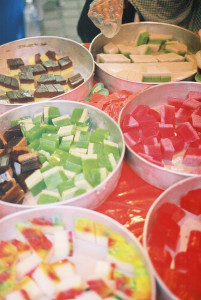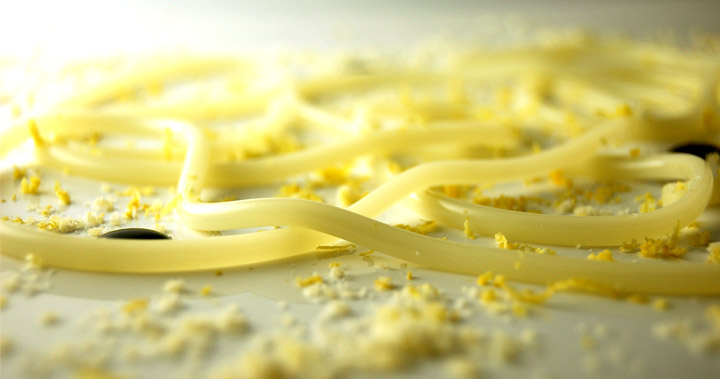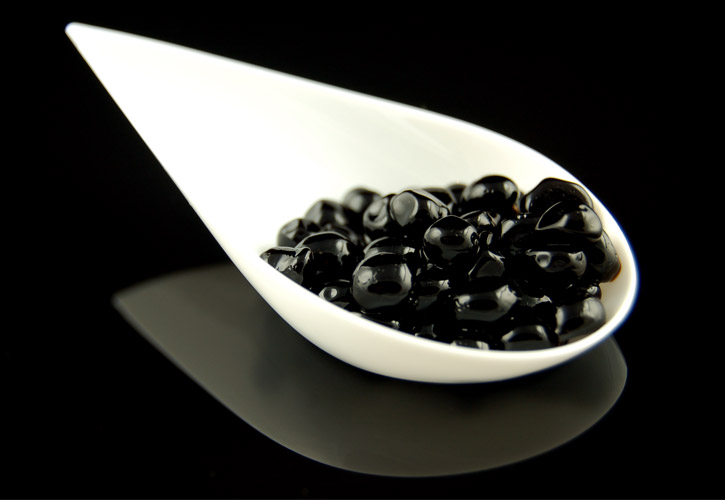Agar Agar (Japanese isinglass, ceylon moss, kanten)
Agar Agar (also known as agar) is a hydrocolloid used for gelling at high temperatures and as a vegetarian gelatin substitute. It can be used to create hot gels and cold gels that don't melt at room temperature, to thicken liquids, produce fluid gels and to clarify stocks. Chef Ferran Adria used Agar to create his famous agar spaghetti and cold oil spherification technique to make small pearls of a flavored liquid. To activate agar, it needs to be boiled for two minutes and a gel will form as temperatures drop below 88°F/32°C. The gel melts at 185°F/85°C.
Agar Origin
 Agar is a natural polysaccharide (starch) product extracted from certain species of red algae. It is a mixture made up predominantly by the straight-chain polymer agarose and less so by the heterogenous mixture agaropectin. Agar is 80% fiber.
Agar is a natural polysaccharide (starch) product extracted from certain species of red algae. It is a mixture made up predominantly by the straight-chain polymer agarose and less so by the heterogenous mixture agaropectin. Agar is 80% fiber.
Whereas traditional gelatin relies on the properties of animal proteins derived from cartilage and bone for gelling, the red algae that power agar are bacteria, not animals. For that reason, agar is a good vegan alternative for gelatin.
Before the modernist movement in gastronomy, agar was most commonly used in Asian cuisine to produce desserts such as the jellies pictured at left and other similar confections. The word "agar" comes from the Malaysian name for the red algae from which it is derived - "agar-agar." In many cultures, agar is sold as "agar-agar." Other common names include Japanese isinglass, ceylon moss, and kanten.
Agar Function
In smaller amounts, it thickens liquids much like the gelatin in a rich stock. At higher concentrations, agar forms an increasingly stronger gel. Of note, agar stays gelled at room temperature: its melting point is 185°F/85°C. A strong agar gel may also be blended and used as a fluid gel.
Agar Applications
Agar is used in molecular gastronomy to make a wide variety of dishes including agar spaghetti, balsamic vinegar pearls with the cold oil spherification method, hot gels, cold gels, fluid gels and clarifying stock. It can also be used to reduce formation of crystals in ice cream.
Agar Agar Spaghetti, also called molecular spaghetti or flavored spaghetti, is another creation of molecular gastronomy Chef Ferran Adria and El Bulli team. It consists of a spaghetto or noddle usually about 3 mm to 5 mm thick and 2 m long made of a flavored liquid jellified with agar agar. The spaghetti can be served cold or hot. The picture below shows the Parmesan Agar Spaghetti.

The cold oil spherification method consists of cooling droplets of a hot agar solution below 35 ˚C (95 ˚F) by releasing them in cold oil using a syringe or pipette. Agar agar needs to be heated to boil for jelling and sets at a temperature of about 32˚C (88˚F). The droplets need to cool down and set before they reach the bottom of the cold oil container to keep a nice spherical shape. The picture below shows the balsamic vinegar pearls made using this method.

Agar can also be used to clarify stocks by replacing gelatin in the original "gelatin filtration" method developed by Harold McGee. The gelatin filtration method consists of freezing a stock or other solution containing gelatin and then letting it thaw in the fridge in a fine strainer lined with cheesecloth. The resulting liquid is a perfectly clear consommé containing only water and flavor molecules.
Outside of modernist cuisine, agar can be used as a laxative given its high fiber content, as an appetite suppressant as it triples in size once ingested as it absorbs water and as a culture medium for various microorganisms, particularly for bacteria.
Agar Properties
Temperature (gels and melts): boil for two minutes to fully activate the agar; a gel will form at temperatures below 88°F/32°C. The gel melts at 185°F/85°C. Agar gels very fast as temperature drops making it very convenient for applications such as agar spaghetti and balsamic vinegar pearls.
Texture: Generally considered to be a similar texture to normal gelatin, but slightly more brittle. Other hydrocolloids can be combined with agar to modify the texture of finished recipes.
Appearance: Semi-transparent. Not as clear as gelatin. Agar Agar is not completely clear when it gels so for some preparations using clear liquids, the presentation may not be as good as it would be when done with gelatin.
Flavor release: Excellent, for a hard gel.
Mouthfeel: Varies, depending on application, but think jellies.
Freeze / Thaw stable: No, syneresis caused by freezing.
Syneresis (weeping): Yes, especially in low concentrations. To prevent syneresis in agar gels, replace 0.1%-0.2% agar with locust bean gum.
Shearing: Creates a shear-thinned gel, otherwise known as a fluid gel.
Hysteresis: 140°F/60°C (approximately)
Interactions and Tolerance of Agar
PH Tolerance: Agar gels will weaken over time at a pH below 6.0. Much more about agar and pH here.
Sugar Tolerance: Sugar content has also a considerable effect over agar gel. Increasing levels of sugar make gels with harder but less cohesive texture.
Other Tolerances: Will gel in the presence of alcohol, but the gel weakens as alcohol concentration increases.
Synergies with other ingredients: The most common reason to combine other ingredients with agar is to fine-tune the texture of finished recipes. For example, to make a gel more or less brittle or elastic. To prevent syneresis in agar gels, replace 0.1%-0.2% agar with locust bean gum.
How to use Agar
Concentration Range: 0.5-2% for most applications. To replace gelatin, 1 packet Knox = 4 gelatin sheets = 1/2 teaspoon agar agar powder.
In smaller amounts, agar thickens liquids much like the gelatin in a rich stock. At higher concentrations, agar forms an increasingly stronger gel. Of note, agar stays gelled at room temperature: its melting point is 185°F/85°C. A strong agar gel may also be blended and used as a fluid gel.
Dispersion: Agar won't dissolve in cold water; the best way to disperse it is to boil it for several minutes.
Hydration: Whisk in cold water, then boil for 2 minutes.
If you try to use agar without first properly dispersing and and hydrating it, you'll end up with clumps of gel in liquid rather than a uniform gel. To make sure all the agar dissolves, first whisk into cold water, then boil for at least 2 minutes. The mixture will set once it cools to room temperature.
It is ok to boil the agar in a smaller amount of a target liquid and then combine that liquid with a larger amount of already cooled liquid in order to avoid boiling all the liquid.
Setting: after boiling for two minutes to fully activate the agar; a gel will form at temperatures below 88°F/32°C.
Special uses: Clarification
Agar can be used for two types of clarification. In small concentrations, agar can be added to a liquid (such as a juice or wine), where it will bind with solid particles and allow them to be more easily filtered out. In a more modernist technique, a weak agar gel is made, then broken up and encouraged to release some of its liquid through a cheesecloth. The liquid released, through syneresis, comes out clarified.
Chemical Reaction
The gelling portion of agar-agar has a double helical structure. Double helices aggregate to form a three-dimensional structure framework which holds the water molecules within the interstices of the framework. Thus, thermo-reversible gels are formed. The gelling property of agar-agar is due to the three equatorial hydrogen atoms on the 3,6-anhydro-L-galactose residues, which constrain the molecule to form a helix. The interaction of the helixes causes the formation of the gel.





 (5 votes, average: 3.80)
(5 votes, average: 3.80)
